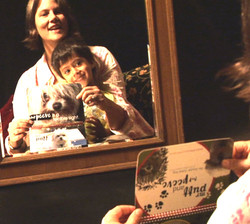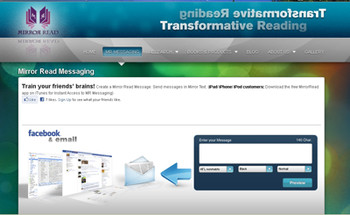Simple Technologies Transform Our Brains
My interest in mirror writing was piqued because I was good at it. Twenty years ago, I started writing mirror-text letters by hand after being inspired by an article about Lewis Carroll. Later, I used my computer to compose stories for nieces and nephews in mirror formats.

Inside the classroom, for the last six or seven years, I have done a lot of lectures on brains and the plurality between the left and right hemispheres. I have used my fascination with mirror reading to explore these topics by means of different technologies in the classroom. One of the most useful tools is a simple overhead projector, and transparencies to reverse images.

Example of mirror reading
I’ve noticed in my classes that some students are faster at reading mirror reversed text than others. Consistent with some research, it seems that my Jewish, Arabic and the Farsi-reading students have split second advantages in mirror reading over those of us whose mother tongues are written from left to right. They may pick up the process a little quicker because they’ve already got the eye movements from right to left that most of us have never practiced.
I can also see who among my students can read these texts the fastest; I find that there is an amazingly large number of male students who finish rapidly. This is exciting for me because sometimes male students don’t always show the highest amount of motivation. When they have a chance to put up their hands, and I can say that they’re doing something well, I see them get interested. In my classroom, this exercise leads to discussions of decoding and how we understand letters and interpret word combinations. I am able to say that this skill is not easy for everyone – which they did so easily – and we can talk about neurons and learning development. Students may not realize their significance until I introduce the vocabulary afterwards. Not bad for an activity based on an overhead projector!
Recently released video about mirror reading, another slick resource in contrast to lower tech methods that nonetheless have their place in the classroom
Although these low-tech demonstrations of mirror reading and writing work well in my Dawson classes, last winter I had a transformative experience in Japan.
Another fascinating exercise that uses technology from a much earlier age is mirror tracing. I ask my students to draw over the image of a star on a sheet of paper by looking at its reflection in a mirror. This is not an easy task, but its mastery teaches us a lot about how our brains process information. It gives an understanding of eye hand coordination, and left to right processing. These active learning capsules are extremely effective.
Although these low-tech demonstrations of mirror reading and writing work well in my Dawson classes, last winter I had a transformative experience in Japan. I visited instructor-friends doing neurolinguistic studies at universities and they asked me to present a lecture on mirror reading in English. Their students were thrilled and kept on talking about incorporating mirror reading into an online game. They wanted to know the address of my website. I realized I was seriously behind the times, and when I came back to Canada I immediately contacted a web designer who helped me put one together.

The Messaging Page of the Mirror Read website
We began adding things gradually. One of the things that I wanted the website to be was a center for a community of research since I had been intrigued by this topic for so long. In the last 10 years, investigations in the area have become much more common. I organized all the literature and images, designed the forum and started a blog. My designer helped me get all of this online at www.mirrorread.com.
There is also now a Mirror Read Messaging module where a note you write is transformed into reverse in a funny font in the colour of your choice, ready to e-mail, send to Facebook or download to your hard drive to make labels. I’ve had people who posted sticky notes with mirror-texted inspirational sayings all over their office!
Getting the website and the blog online, however, didn’t mean that I would use it in my classes. Part of my concern is that what I’m doing is fairly commercial, and I don’t want to be marketing myself to my students. Although I avoid mentioning that the website is mine, if we are exploring brain development and mirror reading, the website is very useful. I can type messages about psychology, and I mirror it on the Message Module turning this activity into a discussion about brain decoding and symbols.
Adding information technology to the mix does not diminish the value of simpler illustrations.
I have also developed a suite of Mirror Read educational games now selling on iTunes that can create interesting and competitive class activities. There is Backword Scramble where you can create words from an array of mirror-reversed letters. An easy word-find becomes a code-cracking puzzle. There is also Headline News where you can challenge your brain and get new content too. Your choice of articles from leading RSS feeds of World, Entertainment, Sports, Tech and Financial are mirrored to give reading activities an extra right-brain challenge.
It has often been said that information technology should only be used if it brings something extra to the class that more traditional methods cannot. I have realized that my classes have been enriched by technology at all levels. Using simple technology can be sophisticated and transformative. Adding information technology to the mix does not diminish the value of simpler illustrations.
Do traditional technologies mix harmoniously with information technology in your classes?

